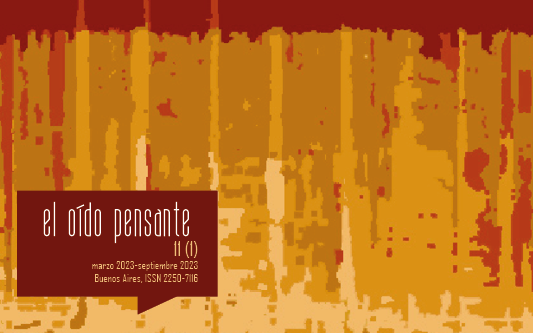“Simplemente voy con lo que me parece bien”. Variedad y coincidencia en la práctica de las mezclas de música metal
Resumen
La música metal es un género que se define por la transgresión, generalmente mediante la búsqueda musical de la pesadez. Resulta interesante que este criterio comúnmente aceptado para definir el género y que implica la idea de progreso, entra en conflicto con las sugerencias recientes de que la producción de música metal se está estandarizando cada vez más, lo que podría obstaculizar su evolución musical. Este estudio, basado en entrevistas con ocho productores importantes de la música metal, investiga los enfoques de mezcla de los profesionales para determinar si coinciden con la presunta estandarización. El estudio encuentra enfoques comunes que resultan de los requisitos técnicos de la ingeniería de música rápida, compleja y sonoramente densa. Sin embargo, existen importantes alternativas entre las que los productores eligen para conseguir los resultados estéticos deseados. Un género polifacético como el metal, con sus diversos subgéneros, requiere más de un enfoque de producción, y la combinación única y la aplicación matizada de estos enfoques facilitan resultados originales. Teniendo esto en cuenta, se puede considerar que los diversos enfoques, procesos y técnicas de producción evolucionan junto con los subgéneros y estilos musicales, para dar apoyo la búsqueda de la transgresión y pesadez del género.Descargas
Citas
Anthony, B. (2017). A Final Guiding Hand: A Practice-Based Study into the Evolving Role of Third Party Mixers. IASPM Journal, 7(2), 41-47. Doi: 10.5429/2079-3871(2017)v7i2.7en
Auvinen, T. (2017). A New Breed of Home Studio Producer? Agency and the Idea ‘Tracker’ In Contemporary Home Studio Music Production. Journal on the Art of Record Produc-tion, 11. Retrieved from https://www.arpjournal.com/asarpwp/a-new-breed-of-home-studio-producer-agency-and-the-idea-tracker-in-contemporary-home-studio-music-production
Bennett, S. (2019). Modern Records, Maverick Methods. London: Bloomsbury.
Berger, H., and Fales, C. (2005). Heaviness in the Perception of Heavy Metal Guitar Timbres: The Match of Perceptual and Acoustic Features over Time. In P. Greene and T. Porcello (Eds.). Wired for Sound (pp. 181-197). Middletown: Wesleyan University Press.
Creswell, J. (2013). Qualitative Inquiry and Research Design: Choosing among Five Ap-proaches. London: SAGE.
Dale, P. (2016). Popular Music and the Politics of Novelty. London: Bloomsbury.
Deeks, M. (2016). National Identity in Northern and Eastern European Heavy Metal (doctoral thesis). University of Leeds, Leeds, UK.
Filho, J. C. (2010). From Performance to Recording: Assumptions of the Aesthetics of Rock Debate. E-Compós, 13(2), Doi: 10.30962/ec.491.
Flick, U. (2010). An Introduction to Qualitative Research. London: SAGE.
Herbst, J.-P. (2017a). Historical Development, Sound Aesthetics and Production Techniques of the Distorted Electric Guitar in Metal Music. Metal Music Studies, 3(1), 24-46. Doi: 10.1386/mms.3.1.23_1
Herbst, J.-P. (2017b). Shredding, Tapping and Sweeping: Effects of Guitar Distortion on Playability and Expressiveness in Rock and Metal Solos. Metal Music Studies, 3(2), 231-250. Doi: 10.1386/mms.3.2.231_1
Herbst, J.-P. (2019). The Formation of the West German Power Metal Scene and the Ques-tion of a ‘Teutonic’ Sound. Metal Music Studies, 5(2), 201-223. Doi: 10.1386/mms.5.2.201_1
Herbst, J.-P. (2020). From Bach to Helloween. ‘Teutonic’ Stereotypes in the History of Popu-lar Music. Metal Music Studies, 6(1), 87-108. Doi: 10.1386/mms_00006_1
Herbst, J.-P. and Bauerfeind, K. (2021). Teutonic Metal: Effects of Place- and Mythology-based Labels on Record Production. International Journal of the Sociology of Leisure, 4, 291-313. Doi: 10.1007/s41978-021-00084-5
Herbst, J.-P. and Mynett, M. (2021a). Nail the Mix: Standardization in Mixing Metal Music?. Popular Music and Society, 44(5), 628-649. Doi: 10.1080/03007766.2021.1957544
Herbst, J.-P. and Mynett, M. (2021b). (No?) Adventures in Recording Land: Engineering Conventions in Metal Music. Rock Music Studies. Doi: 10.1080/19401159.2021.1936410
Herbst, J.-P. and Mynett, M. (2022a). Towards a Systematic Understanding of “Heaviness” in Metal Music Production. Rock Music Studies, 10(1), 16-37. Doi: 10.1080/19401159.2022.2109358
Herbst, J.-P. and Mynett, M. (2022b). What is “Heavy” in Metal? A Netnographic Analysis of Online Forums for Metal Musicians and Producers. Popular Music and Society, 45(5), 633-653. Doi: 10.1080/03007766.2022.2114155
Herbst, J.-P. and Mynett, M. (2023). Mapping the Origins of Heaviness between 1970-1995: A Historical Overview of Metal Music Production. In J.-P. Herbst (Ed.). The Cambridge Companion to Metal Music. Cambridge: Cambridge University Press (forthcoming).
Izhaki, R. (2013). Mixing Audio. London: Focal Press.
Kahn-Harris, K. (2007). Extreme Metal. Oxford: Berg.
Keightley, K. (2001). Reconsidering Rock. In S. Frith, W. Straw and J. Street (Eds.). The Cambridge Companion to Pop and Rock (pp. 109-142). Cambridge: Cambridge Universi-ty Press.
Krotz, A. and Hodgson, J. (2019). Mixing for Markets. In R. Hepworth-Sawyer and J. Hodg-son (Eds.). Mixing Music (pp. 140-152). London: Routledge.
Marrington, M. (2019). The DAW, Electronic Music Aesthetics, and Genre Transgression in Music Production: The Case of Heavy Metal Music. In R. Hepworth-Sawyer (Ed.), Pro-ducing Music (pp. 52-74). London: Routledge.
Martin, A. (2015). The Role and Working Practice of Music Producers (doctoral thesis). Uni-versity of Hull, Hull, UK.
Moore, A. (2019). Tracking with Processing and Coloring as You Go. In R. Hepworth-Sawyer (Ed.). Producing Music (pp. 209-226). London: Routledge.
Moylan, W. (2002). The Art of Recording. Amsterdam: Focal Press.
Mynett, M. (2016). The Distortion Paradox: Analyzing Contemporary Metal Production. In A. Brown, K. Spracklen, K. Kahn-Harris and N. Scott (Eds.). Global Metal Music and Culture (pp. 68-88). London: Routledge.
Mynett, M. (2017). Metal Music Manual: Producing, Engineering, Mixing, and Mastering Contemporary Heavy Music. London: Routledge.
Mynett, M. (2019a). Defining Contemporary Metal Music: Performance, Sounds and Practic-es. Metal Music Studies, 5(3), 297-313. Doi: 10.1386/mms.5.3.297_1
Mynett, M. (2019b). Heaviness in Three Dimensions: The Use of Sonic Space in Contempo-rary Metal Music Production. In S. Zagorski-Thomas, K. Isakoff, S. Stévance and S. Lacasse (Eds.), Art of Record Production: Creative Practice in the Studio (pp. 66-79). London: Routledge.
Mynett, M. (2020). Maximum Sonic Impact: (Authenticity/Commerciality) Fidelity-Dualism in Contemporary Metal Music Production. In S. Zagorski-Thomas and A. Bourbon (Eds.). The Bloomsbury Handbook of Music Production (pp. 293-302). London: Blooms-bury.
North, M. (2013). Novelty: A History of the New. Chicago: University of Chicago Press.
Reynolds, S. (2011). Retromania: Pop Culture’s Addiction to its Own Past. London: Faber and Faber.
Savage, S. (2014). Mixing and Mastering in the Box. Oxford: Oxford University Press.
Schmidt-Horning, S. (2013). Chasing Sound. Baltimore: Johns Hopkins University Press.
Thomas, N. (2015). The Development of Technology and its Influence on Recorded Heavy Metal Music 1969-2015 (Ph.D. thesis). University of Hull, Hull, UK.
Thomas, N. and King, A. (2019). Production Perspectives of Heavy Metal Record Producers. Popular Music, 38(3), 498-517. Doi: 10.1017/S026114301900031X
Turner, D. (2009). Outlining the Fundamental Production Aesthetics of Commercial Heavy Metal Music Utilising Systematic Empirical Analysis. Art of Record Production Confer-ence. Retrieved from https://www.artofrecordproduction.com/aorpjoom/symposiums/21-arp-2009/117-turner-2009
Wallach, J., Berger, H. and Greene, P. (2011). Affective Overdrive, Scene Dynamics, and Identity in the Global Metal Scene. In H. Berger, J. Wallach and P. Greene (Eds.). Metal Rules the Globe (pp. 3-33). Durham: Duke University Press.
Wallmark, Z. (2018). The Sound of Evil: Timbre, Body, and Sacred Violence in Death Metal. In R. Fink, M. Latour and Z. Wallmark (Eds.). The Relentless Pursuit of Tone (pp. 65-87). Oxford: Oxford University Press.
Walser, R. (1993). Running with the Devil. Hanover: Wesleyan University Press.
Zak, A. (2001). The Poetics of Rock. Berkeley: University of California Press.























